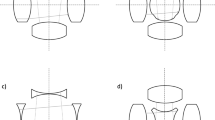Abstract
Let [a,b] be a line segment with end points a, b and ν a point at which a viewer is located, all in R 3. The aperture angle of [a,b] from point ν, denoted by θ(ν), is the interior angle at ν of the triangle Δ(a,b,ν). Given a convex polyhedron P not intersecting a given segment [a,b] we consider the problem of computing θmax(ν) and θmin(ν), the maximum and minimum values of θ(ν) as ν varies over all points in P. We obtain two characterizations of θmax(ν). Along the way we solve several interesting special cases of the above problems and establish linear upper and lower bounds on their complexity under several models of computation.
Similar content being viewed by others
References
Avis, D., Beresford-Smith, B., Devroye, L., ElGindy, H., Guevremont, E., Hurtado, F. and Zhu, B.: Unoriented q-maxima in the plane, In: Proc. 16th Australian Conference in Computer Science, Brisbane, 1993.
Bose, P., Guibas, L., Lubiw, A., Overmars, M., Souvaine, D. and Urrutia, J.: The floodlight problem, In: Fifth Canadian Conference on Computational Geometry, Waterloo, Canada, August 1993, pp. 399–405.
Bose, P., Hurtado-Diaz, F., Omaña-Pulido, E. and Toussaint, G. T.: Some aperture angle optimization problems, Technical Report No. SOCS 93.14, School of Computer Science, McGill University, December 1993.
Bose, P., Hurtado-Diaz, F., Omaña-Pulido, E. and Toussaint, G. T.: Some aperture angle optimization problems, In: 892nd Meeting of the Amer. Math. Soc., Polytechnic University, Brooklyn, New York, 8–10 April 1994.
Chazelle, B. and Dobkin, D. P.: Intersection of convex objects in two and three dimensions, J. ACM 34(1) (1987), 1–27.
Chen, L.-L. and Woo, T. C.: Computational geometry on the sphere with application to automated machining, Trans. ASME 114 (June 1992).
Colly, J., Devy, M., Ghallab, M. and Pampagnin, L.-H.: Sensory control for 3d environment modeling, In: IARP Workshop on Multisensor Fusion and Environment Modeling, Toulouse, 16–17 October 1989.
Cowan, C. K.: Model-based synthesis of sensor location, In: Proc. IEEE Internat. Conf. Robotics and Automation, Philadelphia, April 1988, pp. 900–905.
Davis, G.: Computing separating planes for a pair of disjoint polytopes, In: Proc. ACM Sympos. Computational Geometry, Baltimore, Maryland, 5–7 June 1985, pp. 8–14.
Devroye, L. and Toussaint, G. T.: Convex hulls for random lines, J. Algorithms 14 (1993), 381–394.
Dörrie, H.: Triumf der Mathematik, Physica-Verlag, Wiirzburg, 1958.
Edelsbrunner, H.: Computing the extreme distances between two convex polygons, J. Algorithms 6 (1985), 213–224.
Gill, P. E., Murray, W., Saunders, M. A. and Wright, M. H.: Linearly constrained optimization, In: M. J. D. Powell (ed.), Nonlinear Optimization 1981, Academic Press, New York, 1982, pp. 123–139.
Jacobson, N.: Basic Algebra I, W. H. Freeman, San Francisco, 1974.
Mehlhorn, K.: Multi-dimensional Searching and Computational Geometry, Springer-Verlag, New York, 1984.
Niven, I.: Maxima and Minima Without Calculus, Math. Assoc. America, 1981.
O'Rourke, J.: Art Gallery Theorems and Algorithms, Oxford Univ. Press, 1987.
Powell, M. J. D.: Introduction to constrained optimization, In: P. E. Gill and W. Murray (eds), Numerical Methods for Constrained Optimization, Academic Press, London, 1974, pp. 1–28.
Preparata, F. P. and Shamos, M. I.: Computational Geometry, Springer-Verlag, New York, 1985.
Schwartz, A.: Analytic Geometry and Calculus, Holt, Rinehart & Winston, 1960.
Shermer, T.: Recent results in art galleries, Proc. IEEE 80 (1992), 1384–1399.
Spyridy, A. J. and Requicha, A. G.: Accessibility analysis for the automatic inspection of parts, In: Proc. IEEE Int. Conf. Robotics and Automation, Cincinnati, OH, U.S.A., 13–18 May 1990, pp. 1284–1289.
Tang, K., Woo, T. and Gan, J.: Maximum intersection of spherical polygons and work-piece orientation for 4-and 5-axis machining, J. Mechanical Design 114 (1992), 477–485.
Teichman, M.: Wedge placement optimization problems, Master's thesis, School of Computer Science, McGill University, 1989.
Toussaint, G. T.: Solving geometric problems with the ‘rotating calipers’, In: Proc. IEEE MELECON, Athens, Greece, May 1983.
Uspensky, J. V.: Theory of Equations, McGraw-Hill, New York, 1948.
Vasilev, N. B. and Gutenmajer, V. L.: Rectas y Curvas, Mir, Moscow, 1980. Spanish translation.
Woo, T. C.: Visibility maps and spherical algorithms, Computer Aided Design 26(1) (1994), 1–16.
Author information
Authors and Affiliations
Rights and permissions
About this article
Cite this article
Omaña-Pulido, E., Toussaint, G.T. Aperture-Angle Optimization Problems in Three Dimensions. Journal of Mathematical Modelling and Algorithms 1, 301–329 (2002). https://doi.org/10.1023/A:1021666512528
Issue Date:
DOI: https://doi.org/10.1023/A:1021666512528




